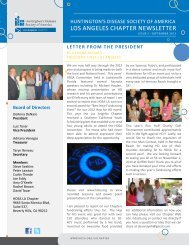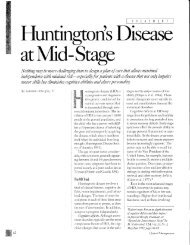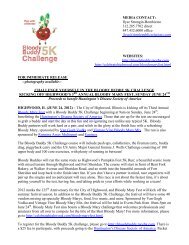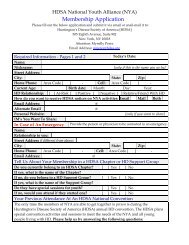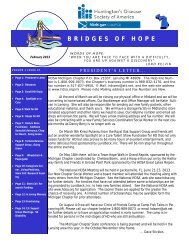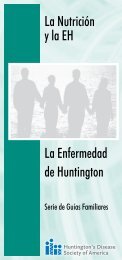Understanding Behavior in HD.final.8-18-05 - Huntington's Disease ...
Understanding Behavior in HD.final.8-18-05 - Huntington's Disease ...
Understanding Behavior in HD.final.8-18-05 - Huntington's Disease ...
Create successful ePaper yourself
Turn your PDF publications into a flip-book with our unique Google optimized e-Paper software.
20<br />
Articulation impairments have become one of the hallmark symptoms of <strong>HD</strong>. Many persons affected by<br />
<strong>HD</strong> have been accused of “dr<strong>in</strong>k<strong>in</strong>g too much” because their speech is slurred. One of the “circuits” that relays<br />
<strong>in</strong>formation through the caudate is the motor circuit—the pathway for motor <strong>in</strong>formation that tells the body<br />
how to move specific muscles at precisely the right time. When the caudate becomes affected by <strong>HD</strong>, it is<br />
unable to regulate how motor <strong>in</strong>formation flows from one part of the bra<strong>in</strong> to another. One consequence is<br />
that some motor movements occur randomly (this is known as chorea). Another consequence is that the bra<strong>in</strong><br />
is unable to control motor movements throughout the body. Talk<strong>in</strong>g requires very complex motor movements<br />
of the mouth and tongue, breath<strong>in</strong>g control and so on. Without the caudate to regulate all of the different<br />
aspects of talk<strong>in</strong>g, speech becomes disorganized, poorly timed and not adequately supported by breath.<br />
Unfortunately, slurred speech is one of the ma<strong>in</strong> reasons that unaffected <strong>in</strong>dividuals stop communicat<strong>in</strong>g with<br />
<strong>HD</strong>-affected persons. Unaffected <strong>in</strong>dividuals are uncomfortable that they cannot understand what is be<strong>in</strong>g said<br />
to them and, oftentimes, they stop try<strong>in</strong>g.<br />
Initiat<strong>in</strong>g, or start<strong>in</strong>g, speech is also severely impaired by the damage to the caudate <strong>in</strong> the bra<strong>in</strong>. The<br />
degeneration that occurs <strong>in</strong> the caudate is due to the death of the medium sp<strong>in</strong>y neurons (a specific type of<br />
bra<strong>in</strong> cell). Here is a picture of three of this<br />
k<strong>in</strong>d of neuron. Notice the number of long<br />
dendrites that flow off of the center, or body,<br />
of each neuron. These long dendrites are used<br />
to send <strong>in</strong>formation through one neuron and<br />
on to the next.<br />
As a neuron degenerates, or dies, the<br />
<strong>in</strong>formation cannot be passed along the circuit as easily. Imag<strong>in</strong>e the dendrites of the neuron to be roads <strong>in</strong> a<br />
large freeway system. The nucleus of the neuron would be a large city and the roads (dendrites) lead to<br />
neighbor<strong>in</strong>g towns. Let’s ask this neural circuit a question, like one you would ask a person with <strong>HD</strong>. “How do<br />
you get to Aunt Mabel’s house?” Typically, we take Highway 5 north to Lakewood Exit and then take County<br />
Road 52 to V<strong>in</strong>etown, where Aunt Mabel<br />
lives on 9th Street. We beg<strong>in</strong> the journey <strong>in</strong><br />
the <strong>HD</strong> “freeway system” only to f<strong>in</strong>d that<br />
Highway 5 is closed for road construction,<br />
and County Road 52 has been washed out<br />
by a recent mud slide and 9th Street is be<strong>in</strong>g<br />
resurfaced and cannot be accessed until<br />
Thursday. Try to f<strong>in</strong>d a detour that can get<br />
you to Aunt Mabel’s house. It is difficult and<br />
it takes longer to get there.



